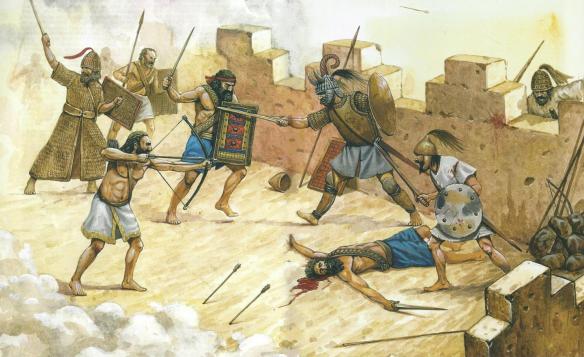Throughout history it has always been difficult for governments to find enough good soldiers. A soldier’s life was and is often very hard, and there is the ever-present danger of loss of life, so for many a military life was not desirable. Warfare in the period from 4000 to 1000 BCE generally involved either local disputes or in some cases wars waged far from home. For example, Thutmose III (ca. 1504-1450 BCE) waged 17 military campaigns outside of Egypt during his reign. Military life for the Egyptian soldiers at this time included long periods away from home and away from their families and professions. Life in the military was often not popular, and many societies in the ancient world suffered shortages in personnel.
Conscription was one obvious way to deal with the shortage, and many ancient cultures adopted it. In the Old and Middle Kingdoms (ca. 2600-1780 BCE) Egypt conscripted 1 in every 100 men into the army, and by the time of Ramses II (ca. 1279-1212 BCE) 1 in 10 men were being conscripted. This was very unpopular, and many Egyptians avoided conscription by hiding or running away. The only way for Egypt and other societies to gain enough soldiers to maintain a large enough standing army was by hiring mercenaries. The period from 4000 to 1000 BCE was premonetary, so mercenaries were not paid in coinage but instead were often given grants of land and a share in the loot from the battle. A military career in Egypt, whether as a mercenary or a regular soldier, was one of the only ways for a peasant or commoner to increase his status and fortune in life.
The first solid references to mercenaries are from the reign of King Sargon of Akkad in Mesopotamia and date to ca. 2350 BCE. Sargon employed perhaps as many as 5,000 mercenaries, mostly recruited from the edges of his empire. These mercenaries also sometimes saw regular police duty and were often used to put down internal riots and revolts. Since they were far from home, they would have no connection with the people they had to control, and Sargon did not have to make his soldiers use violence toward their own people. This allowed Sargon to see his will done without much unrest developing within his military. The Egyptian pharaohs often used the famous Medjay Nubian mercenaries in a similar way. By the time of the Egyptian New Kingdom, the Medjay were unoffcially known as the Egyptian police force.
The most notable force of mercenaries in the ancient world were the Habiru. This group or culture was known across the ancient Middle East and appears in the documents of many cultures from 2500 BCE through to about 1000 BCE. Its origin is unknown, and there were groups of Habiru in many regions. The ancient texts note that they were sometimes hired for domestic purposes but most often as mercenaries. By the fourteenth century BCE the Habiru had become very successful as mercenaries, and their population had grown to the extent that they were able to take control of various towns and cities in the Levant, including Hazor and Byblos.
The Canaanite kings supplemented their forces with hired freebooters called apiru (sometimes known as habiru). The apiru were a class of outcasts, debtors, outlaws, and restless nomads who formed themselves into wandering groups of raiders, often hiring themselves out to princes and kings for military duty. These wandering brigands were a serious threat and often had to be brought to heel by the Canaanite princes by force of arms. One of history’s greatest generals, David, was an apiru. When forced to leave Saul’s court for fear of being killed, David returned to his old mercenary occupation by raising a force of 600 “discontented men” and hiring his soldiers out to one of the Philistine kings. The size and military sophistication of these brigand groups could present a considerable threat to public order. A record from Alalakh tells of a band of apiru comprising 1,436 men, 80 of which were charioteers and 1,006 of which were shananu, probably some kind of archer. Another text records the capture of the town of Allul by a force of 2,000 apiru.
However, with the collapse of the great city-states at the end of the Late Bronze Age (ca. 1050 BCE), the Habiru disappear from history. It is possible that in all the upheaval of the period they were incorporated into what remained of society after the fall of the elite polities of the period
Bibliography Keegan, John. A History of Warfare. New York: Vintage Books and Random House, 1994. Yalichev, Serge. Mercenaries of the Ancient World. London: Constable and Company, 1997
